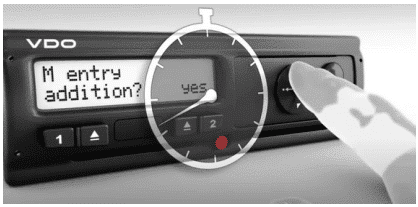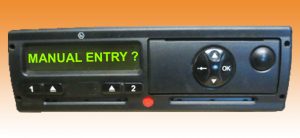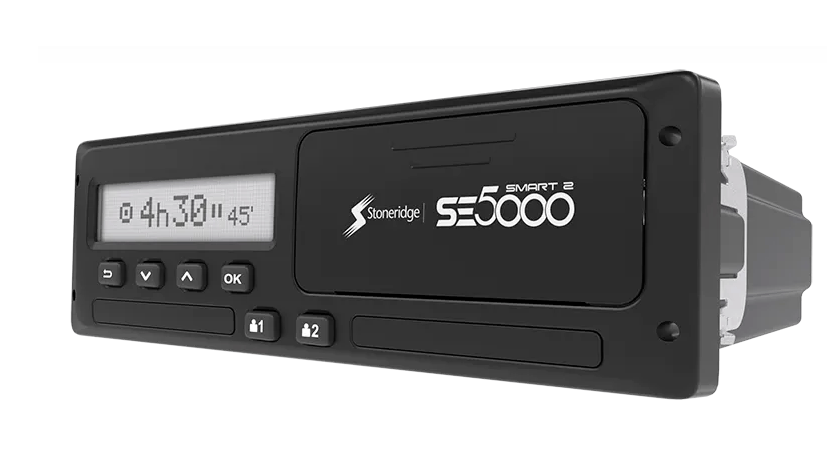For HGV and bus drivers in the UK, keeping accurate records of working time and rest is not just about safety, it is also a legal requirement. Tachographs record this information automatically, but there are times when gaps appear that must be filled manually. This is where the manual entry tacho function comes in, ensuring a complete and compliant record.
A manual entry helps drivers record rest, standby, or other activities when their driver card was not inserted. By understanding how to use this function, drivers reduce the risk of fines and improve compliance with DVSA regulations. In 2025, knowing how to manage manual entries is as important as ever, particularly with the rollout of smart tachographs.
What Is a Manual Entry Tacho

A manual entry tacho is a function built into digital and smart tachographs that allows drivers to fill in missing activity periods. For example, if a driver removes their card during rest, they will need to add those hours later to create a complete timeline of work and rest. This ensures nothing is overlooked.
Unlike automatic recordings, manual entries require the driver to input activities such as “rest”, “work”, or “standby”. Without these entries, driving records appear incomplete, raising concerns during roadside checks or inspections. Making a correct manual entry is therefore vital for demonstrating full compliance and protecting a driver’s professional reputation.
UK Manual Entry Tacho Law and Compliance
In the UK, the law is clear: drivers must keep a continuous and accurate record of their hours. This includes making manual entries whenever the tachograph has not automatically recorded time. Manual entry tacho requirements are set out by the DVSA, and failing to comply can have serious consequences.
Drivers who neglect manual entries face fines of up to £300 and the possibility of further enforcement action. These penalties are designed to encourage accuracy and honesty in record keeping. With strict rules surrounding rest periods and working hours, using manual entries correctly is not just good practice—it is a legal necessity.
How to Do a Manual Entry on a Tachograph

Completing a manual entry tacho is not difficult once drivers learn the process. When reinserting the driver card, the system will ask if they wish to add manual entries. Drivers must input the type of activity, start time, and end time for any periods not automatically recorded. This ensures continuity in their records.
The process may differ slightly depending on whether a driver is using an older digital tachograph or a newer smart model. Regardless of the device, the principle remains the same: fill in all missing periods accurately. By carefully entering this information, drivers demonstrate professionalism and maintain compliance with tachograph law.
Manual Entry Tacho Without a Card
Many drivers wonder if they can complete a manual entry tacho without their card inserted. In most cases, the answer is no, because the card is where the data is stored. However, in exceptional circumstances, DVSA guidelines allow drivers to use printouts or written notes to cover activities temporarily.
It is important to remember that written records are only a short-term solution. Once the driver card is available, the data must be updated to ensure consistency. Relying on manual records without the card can lead to errors or suspicion during checks, so drivers should always aim to use the card whenever possible.
Manual Entry Tacho Card Best Practices
The driver card is the backbone of tachograph records, and keeping it accurate is essential. A manual entry tacho relies on the card to save information, meaning drivers should always insert it properly at the start of their shift. Any missed time can then be corrected with a manual entry.
Best practice includes double-checking that entries match card data and avoiding duplicate or conflicting information. Small errors can create big problems during inspections, so attention to detail is crucial. A careful approach ensures records remain clear, accurate, and legally compliant, giving both drivers and operators peace of mind.
Manual Entry Tacho Training for Drivers
Although the manual entry tacho process may seem straightforward, many drivers benefit from training to avoid mistakes. Training provides practical knowledge on when manual entries are needed, how to complete them correctly, and how to avoid common pitfalls that could lead to fines or warnings.
Across the UK, drivers can access classroom-based training or online courses tailored to tachograph compliance. Employers often encourage this training to protect both their business and their drivers. By investing in training, drivers build confidence in handling tachographs and strengthen their ability to remain compliant on the road.
Common Mistakes in Manual Entry Tacho and How to Avoid Them
Mistakes with manual entry tacho are common but preventable. Forgetting to record standby time, entering the wrong date, or failing to log breaks are errors that can cost drivers dearly. These mistakes can lead to fines, warnings, or worse—loss of trust in professional ability.
To avoid problems, drivers should develop a routine of double-checking entries before confirming them. Training and practice also make the process smoother. By being consistent, methodical, and aware of time zones (UTC vs local time), drivers can keep their records error-free and ensure they meet all legal obligations.
Technology and the Future of Manual Entry Tacho
The introduction of smart tachographs has changed how manual entries are handled. These newer devices can automatically record more data, including location information, reducing the need for frequent manual inputs. However, manual entry tacho will not disappear entirely, as some situations will always require human input.
Technology will continue to evolve, making tachographs more accurate and easier to use. Still, drivers must stay informed about updates to ensure they remain compliant. Embracing new tools and maintaining good habits with manual entries is the best way to balance technology and responsibility in the future.
Conclusion
Manual entry tacho remains a vital skill for UK drivers in 2025. While tachographs capture most activity automatically, it is the driver’s responsibility to ensure all periods are correctly recorded. Proper manual entries protect drivers, operators, and the public by ensuring compliance with strict working time laws.
By following best practices, investing in training, and keeping up with evolving tachograph technology, drivers can remain confident in their records. Accuracy is not just about avoiding fines—it is about building a safe and professional transport industry for the future.
FAQs about Manual Entry Tacho
What is the purpose of a manual entry on a tachograph?
Is it legal to drive without making a manual entry?
Can I do a manual entry on a tachograph without a driver card?
How do I correct a mistake on a manual entry?
What are the UK penalties for failing to make a manual entry?
Do I need manual entry tacho training to stay compliant?
Are manual entry rules different for buses and HGVs?
What happens if my tachograph machine fails during a shift?
Do manual entries need to be made in UTC or local UK time?
How often are tachograph laws updated in the UK?
You may also read: Bellahouston Sports Centre: Glasgow Gym, Swimming Pool, and Fitness Classes


